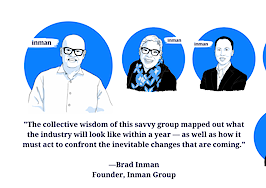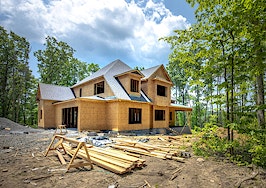This is the first part is a multi-story series on the spring housing market, and what different chapters from history might tell us about the present. Check back in the coming days for stories on housing inventory and migration patterns. Also be sure to join us in person from Aug. 8-10 for Inman Connect Las Vegas, where we’ll discuss in person how the spring played out.
Inflation was spiking. Prices were getting away from consumers, and politicians were feeling the heat. The Federal Reserve had to do something.
And it did, pushing rates up at an unprecedented pace. Almost on a dime, the cost of borrowing money went through the roof. A new reality set in.
That may sound like 2022, but it also — and perhaps more accurately — describes 1979, when inflation rose to more than 11 percent, and then 1980, when it topped out at more than 13.5 percent. And at the time the man leading the Fed wasn’t current Chair Jerome Powell, but rather Paul Volcker, who aggressively and controversially pushed interest rates higher and higher in an incredibly short time.
Volcker’s efforts worked and inflation did come back down, although a pair of recessions ultimately ensued in the early 1980s as well.
Today isn’t a mirror image of the late 1970s and 1980s. But some of the same forces such as inflation and high rates — long absent in any meaningful magnitude — have returned, raising questions about what we can learn about the present by gazing into history. As Shakespeare wrote, the past is prologue.
This week, Inman is setting out to understand what lies ahead for the spring housing market. As part of that project, Inman talked to agents and economists about their forecasts for the coming months, but also looked into chapters in our own history, to era’s like Volcker’s that in some way resemble the present.
Obviously no two moments are the same — history rhymes, after all — but the hope is that by exploring data from periods that resemble the present in some way, it might be easier to anticipate what lies ahead.
This story is consequently the first in Inman’s the “Past is Prologue” series, and will focus specifically on inflation and interest rates. And the takeaway here is that when inflation and rates both soar, the housing market tends to slow down. This spring is thus likely to be slower than recent years. But while that may not be surprising to those in real estate’s proverbial trenches, the good news is that past slowdowns under conditions similar to those that currently exist have not actually been terribly deep or prolonged.
In other words, this spring may be slow. But that doesn’t mean it’s the end of the world.
Inflation rocketed in the 1970s and 1980s
Data from the St. Louis Fed shows, quite clearly, the spike in inflation that took place in the late 1970s. Though inflation was rising through the late 1960s, the first really massive spike happened in 1973. Another followed in 1978. Economists have spent decades studying why these spikes happened, but for our purposes here it’s probably enough to know that they took place as prices for consumer goods shot up amid multiple energy crises, and as wages raced to catch up with those prices hikes.

Credit: Inman
Volcker’s Fed reacted aggressively to the inflation of the late 1970s and early 1980s, and mortgage rates — which the Fed doesn’t set but which are influenced by Fed policies — consequently rose too.
By late 1981, rates were more than 18 percent, something that seems nearly unimaginable by today’s standards.

Credit: St. Louis Fed
By comparison to the 1970s and early 1980s, the current inflation rate of just over 6 percent doesn’t seem so bad. (It’s worth noting that the first graph doesn’t show 2022, so it’s most useful for visualizing historic, rather than current, inflation rates.) Nor does the current average rate of 6.42 percent for a 30-year fixed rate mortgage seem all that terrible. As the second graph above shows, current mortgage rates still remain well below where they were for most of the 1990s.
Still, that period in the 1970s and 1980s is a useful case study in extreme movement; what happens to real estate when rates and inflation go to the moon relative to the immediate past?
Data that the National Association of Realtors (NAR) provided to Inman offers some insights. The chart below, for example, shows the median sales price for a single family home going all the way back to 1968. The inflationary period of the late 1970s and early 1980s, along with the ensuing two recessions, is visible on the graph as a slight leveling out of prices during that same period.

Credit: NAR and Jim Dalrymple II
Data from NAR also shows what happened with home sales during that time. In this case, sales peaked at nearly 4 million in 1978, but fell to just 2.7 million in 1983, after which they began recovering. That’s a drop of about 32.5 percent.

Credit: NAR and Jim Dalrymple II
What all of these numbers show is that the inflation, high rates and recessions that took place around 40 years ago had a modest impact on prices, and a more significant impact on the total number of homes that changed hands. And while that same scenario isn’t what is happening now, similar pressures — albeit in different magnitudes — do exist today.
Ergo, it stands to reason that the number of homes that change hands will go down, and that prices will moderate. And indeed that’s exactly what recent analysis, including a brand new report this week from Redfin, indicates is happening. That Redfin report goes so far as to describe the overall market as “faltering.”
Forecasters with Fannie Mae also expect home sales to decline 18 percent year over year in 2023 — a prediction that seems in line with what happened during past periods of inflation and slowing economic growth.
However, even with all of that in mind, it’s worth noting that the trend for both sales and prices was upward over the long term, and the effects of the tumult of the 1970s and 1980s now all these years later look more like bumps than cataclysms.
The recession of 1990
While the inflation, high rates and recessions of the late 1970s and early 1980s loom large in the minds of armchair historians, experts cautioned that there are some key differences between then and now as well.

Hannah Jones
For example Hannah Jones, an economic research analyst with Realtor.com, told Inman that in prior periods of high rates, home prices weren’t as elevated relative to those rates. So what’s happening now is “a pretty unique situation” because “astronomical price growth” stuck around even as rates climbed. The result is that affordability remains uniquely difficult at the moment.
“We see buyers continued to be dinged by both high prices and high mortgage rates,” Jones said, adding a moment later that “I don’t think we’ve been in this exact situation before.”
Daryl Fairweather, chief economist for Redfin, made a similar point, noting that in past bouts of high inflation “people were still earning wages high enough to afford those interest rates and prices.”

Daryl Fairweather
“There wasn’t this lack of supply in the 1970s that there is now,” she added.
This suggests that, even if rates and inflation are more moderate than they were decades ago, buyers could still have a uniquely difficult time this year.
But it isn’t all bad news. Matthew Gardner, chief economist for Windermere Real Estate, told Inman that another key difference between the late 1970s and the present is that people are more transitory. They stay at jobs for less time, and thus end up driving more demand for new homes.
Other key demographic shifts set the present apart as well, such as the fact that people today tend to get married later, and more people don’t get married at all. The point is that lifestyles have shifted, and as Gardner put it, “people move more” now than they did in the past.
Gardner also believes there’s a better parallel for the present than the inflation and recessions of the 1980s. While he thinks that it’s “quite likely” that a recession will set in later during 2023 — a prediction Fannie Mae forecasters also made — it won’t be like the most famous recessions mentioned in the section above.
“It’ll be more similar to 1990 than to 2007,” Gardner speculated.
Gardner went on to say that the recession he was referring to began in July 1990 and ended in February 1991. Housing did “pull back” during that recession, and Gardner said that at the low point prices actually dipped 6 percent.
However, by the time the recession ended, prices were climbing again and over the course of the entire period they ultimately rose 1 percent.
The chart below further shows what happened month by month to home sales during that period, with a dip coinciding with the onset of that recession and ending soon after the economy recovered.

Existing home sales in millions. Credit: NAR and Inman
The same dip is also visible in the annual home sales graph in the section above. That data shows that the total number of homes sold in the U.S. fell each year beginning in 1988, when 3.5 million homes sold, to 1991, when only 2.9 million traded hands.
But sales then began rising again in 1992. By 1994, they hit a new all-time high by slightly surpassing 1988. Every year after that sales hit a new all-time high all the way until 2006, when the market and broader economy began wobbling.
That’s a lot of numbers and a fair amount of history to digest, but the larger point is relatively simple: The recession of 1990 did ding the housing market. But it wasn’t long before the market recovered and rose to new heights. And if the past is prologue, it’s possible something similar may happen again.
Fairweather described a similar such outcome, saying that while the market may slow in 2023, it’s also coming off an extremely heated period. When 2023’s prices and sales are plotted against a longer time span, what happens this year may ultimately look more like a “reset” with a “temporary stalling in home prices” than like a fundamental crumbling of the market.
“The trajectory will look not as extreme any more,” she suggested.
A slow spring — with some potential for hope
Regardless of which historical period, if any, offers the best analog to the present, the experts were generally in agreement about the broad strokes of what lies ahead.
“This selling season is likely to be a lot less active,” Jones said, capturing a sentiment that other experts also shared.
Jones envisions price growth “continuing to decline and soften” as sellers grapple with high rates and buyers who have less purchasing power compared to the recent past. ”
“The lever that the market can pull, that sellers can pull, is prices,” she said.
But that doesn’t mean this spring will be a total bust. Already, numerous agents have reported competition in their markets. That’s in large part due to issues with inventory, which will be the subject of a future post in this series. But a key high-level takeaway is simply that there are still buyers and demand out there.
It’s also possible that demand could tick up. Gardner speculated that rates could actually come down somewhat this year, which would in turn prompt buyers to come out in greater force.
In Jones’ case, she sees rates staying “elevated” for 2023. But she did say that lending and borrowing could become easier as inflation begins to moderate.
Such sentiments aren’t exactly an enthusiastic vote of confidence in the market’s near-term prospects. However, it does mean that experts aren’t expecting the same kind of record inflation and rate hikes this spring that slammed the industry last year. And either way, the coming months are likely to be interesting.
“This year,” Jones concluded, “is probably going to be a much different housing market than the last couple of years.”













